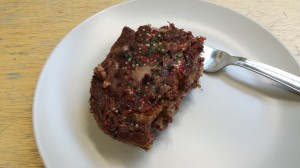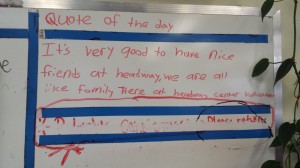When I heard that we would be volunteering at Headway, a flurry of thoughts and emotions coursed through my mind – excitement at the prospect of learning; curiosity; nervousness about what to expect. Having taken courses on brain function and biopsychology and after my classmates’ thought-provoking presentations, I couldn’t help but ponder those concepts in anticipation.
Would communication barriers be present if I encountered members with aphasia? How would I deal with the candor of individuals whose brain injuries impacted their social discretion? What if, in learning about common post-TBI personality changes like aggressive tendencies, my expectations changed the way I interacted with members?
In retrospect, I suppose my inexperience did lead me to have preconceived notions of how TBI survivors appear, act or even feel. But all that dissipated upon entering the centre. I was warmly greeted by an affable young man who cordially shook my hand and directed me to the facilitator. I met the members who were present and it quickly dawned upon me that brain injury truly is unique. Its signs can be present or completely inconspicuous, causing a great deal of variation in presentation and demeanor.
For example, Mr. X had suffered a stroke-induced brain injury, leading to loss of function in some extremities, fatigue and slight cognitive deficits. However, he was a wonderful conversationalist with incredible memory. On the other hand, Mr. Y had speech impairments and frequently expressed fatigue, but enjoyed knitting using an ingenious homemade contraption – a loom built from a yogurt container and popsicle sticks (which he gleefully informed me were all diligently eaten by him). Despite my initial struggle in understanding many of his sentences, he was soon teaching me how to knit and telling me about his family.
After an hour of chatting and my shaky foray into knitting, the baking began. While some members found following the recipe instructions difficult, others carried on with ease. Some lost interest while another demonstrated task perseverance by repeatedly melting butter in the microwave. Indeed, all individuals were vastly different: some spoke fluidly while another primarily gestured as a means of self-expression. But common to all was the ability to come together in a positive space with mutual support and respect.
Interacting with the members was extremely interesting, as was learning how widespread the implications of brain injury are, and how varied post-TBI functioning, attitudes and even relationships can be. I furthermore noticed how their actions embodied community, when members stayed to clean, play games and chat. Their positivity was infectious, and I found myself staying an extra 40 minutes! I certainly gained new insight into the individuals who experience brain injury, the unique challenges they face, and the importance of involvement in shattering preconceptions.




One response to “Baking at Headway – Amanda Lee”